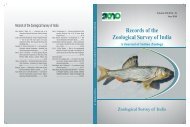Vol. 111 - Part I - Zoological Survey of India
Vol. 111 - Part I - Zoological Survey of India
Vol. 111 - Part I - Zoological Survey of India
You also want an ePaper? Increase the reach of your titles
YUMPU automatically turns print PDFs into web optimized ePapers that Google loves.
12 Rec. zool. Surv. <strong>India</strong><br />
Kolkata; OOL = Ocellocular length; POL = Postocellar<br />
length.<br />
Oreumenoides edwardsii (de Saussure)<br />
(Figs. 1-21 & Plate I)<br />
1852. Eumenes edwardsii de Saussure, Mon. Guep. Sol. P.<br />
60, Female, Syntype, Type loc. Les Indes-Orientales,<br />
Bombay (MP). Additional citations: Smith, 1857, Cat.<br />
Hym. Brit. Mus., V, p. 22; Bingham, 1897, Fauna <strong>of</strong><br />
Brit. <strong>India</strong>, Hym., 1 : 344, Female, Male, des., distr.,<br />
fig., syn.; Dutt, 1912, Mem. Dept. Agr. <strong>India</strong> Ent.<br />
Ser., 4 : 239, nest; Dover & Rao, 1922, J. Asia. Soc.<br />
Ben., N. S. xviii : 238, distr.; Gupta, 1995, Him. Eco.<br />
Series, Hym., zool. Surv. <strong>India</strong>, 83, distr.<br />
1961. Oreumenoides edwardsii (de Saussure): Giordani Soika,<br />
Verh, XI Int., Kongr. Entomol. Wien. 1 : 245, erected<br />
new genus Oreumenoides with type species Eumenes<br />
edwardsii de Saussure by original designation.<br />
Additional citation: Gusenleitner, 2006, Linzer boil.<br />
Beitr., 38(1) : 694, distr.<br />
Redescription : Female: Body length 14-16 mm;<br />
forewing length 11 mm. Body ferruginous red with<br />
yellow and black markings. Yellow markings as follows:<br />
at the clypeus, a triangular mark on interantennal space,<br />
inner margin <strong>of</strong> lower eye extends upto ocular sinus, a<br />
narrow line on outer margin <strong>of</strong> eye (rarely only a spot<br />
dorsally), a spot on ventral side <strong>of</strong> antennal attachment,<br />
a short line on middle <strong>of</strong> the pronotum (rarely the line<br />
extends to sides), a spot on tegula apically, parategula<br />
(rarely brownish yellow), lower half <strong>of</strong> metanotum<br />
(rarely yellowish brown), a small spot on antero-lateral<br />
side <strong>of</strong> propodeum (rarely absent), a small spot on<br />
postero-lateral corner <strong>of</strong> propodeum, propodeal valvula<br />
(rarely yellowish brown), a streak on outer side <strong>of</strong> tibiae<br />
and basitarsi (rarely absent in mid and hind tibiae and<br />
mid and hind basitarsi), a yellow mark on outer side <strong>of</strong><br />
fore, mid and hind femora (rarely absent), a streak on<br />
each side just after middle <strong>of</strong> petiole, two subapical<br />
spots and two spots on postero-lateral corner on the<br />
same above, two lateral oval spots basally and a broad<br />
band apically on second gastral tergite, two spots<br />
postero-laterally on third gastral tergite (sometimes<br />
fourth also), a narrow band on second gastral sternite<br />
apically, a broad band on third and fourth sternite<br />
apically (sometimes fifth and sixth also). Black markings<br />
are as follows : frons except inner ocular sinus, vertex,<br />
temple except ocular margin <strong>of</strong> eye, occiput, mesoscutum<br />
except an M-shaped ferruginous brown marking, apical<br />
margin <strong>of</strong> scutellum, basal half <strong>of</strong> metanotum (sometimes<br />
reduced), axillary fossa, suture between metanotum and<br />
propodeum, median groove <strong>of</strong> propodeum, mesepimeron<br />
largely, ventral side <strong>of</strong> mesosoma, base and middle <strong>of</strong><br />
petiole above, middle <strong>of</strong> second gastral tergite<br />
(sometimes faint medially, appears to be blackish<br />
brown), a broad longitudinal band from base upto<br />
middle <strong>of</strong> second gastral sternite, two lateral spots on<br />
second gastral sternite subapically (sometimes faint,<br />
appears to be blackish brown). Forewing (Fig. 7) almost<br />
hyaline with some brown infumations anteriorly, a<br />
distinct brown infumation on radial cell at distal half;<br />
hindwing hyaline. Body covered with minute silvery<br />
white pubescence, some moderately large silvery white<br />
pubescence in between minute pubescence on frons,<br />
vertex, scutellum, metanotum, dorsal side <strong>of</strong> propodeum<br />
and scattered hairs on gastral segments.<br />
Head : Width in front view (Fig. 1) 1.29x as long as<br />
distance between front ocellus and clypeal margin<br />
medially; width in dorsal view (Fig. 3) 6.7x distance<br />
between front ocellus and posterior occipital margin,<br />
almost equal to (0.98x) mesosoma along tegula; clypeus<br />
convex, minimum width 0.86x its length medially, apex<br />
emarginate with two lateral triangular tooth-like<br />
projections, almost smooth, upper margin emarginate;<br />
mandible (Fig. 2) smooth, with a line <strong>of</strong> large hairs on<br />
inner margin, scattered moderately large hairs on dorsal<br />
surface with few scattered large hairs outwards, very<br />
small closely set hairs basally; supraclypeal area,<br />
interantennal space except anterior portion, inner orbit,<br />
ocular sinus, vertex except at middle, temple and occiput<br />
almost smooth; frons, anterior portion <strong>of</strong> interantennal<br />
space, vertex at middle near to ocellar triangle with<br />
moderately large punctures, interspaces mostly equal<br />
to punctures; POL 2.16x OOL; interocular distance more<br />
on vertex than at clypeus (23:19); temple distinctly<br />
narrower (0.63x) than eye in pr<strong>of</strong>ile (measured through<br />
its ocular sinus) (Fig. 4). Antenna farther from each<br />
other than from eyes (9:3); scape length 1.75x length <strong>of</strong><br />
first flagellar segment (Fig. 5); first flagellar segment<br />
1.71x as long as second flagellar segment, 2.4x as long<br />
as wide; flagellar segments widening towards apex as<br />
in figure 5; apical antennal segment slightly longer than<br />
wide.<br />
Mesosoma : anterior face <strong>of</strong> pronotum smooth;<br />
posterior and lateral portion <strong>of</strong> pronotum, mesoscutum,<br />
scutellum, mesopleuron with moderately strong<br />
punctures; metanotum shiny with scattered punctures;<br />
dorsal side <strong>of</strong> propodeum closely and densely punctate<br />
except at anterior margin towards metanotum smooth,<br />
interspaces mostly less than punctures; metapleuron<br />
and lateral sides <strong>of</strong> propodeum smooth; pronotum with<br />
distinct pretegular carina; median length <strong>of</strong> mesoscutum<br />
as long as its maximum width; parategula (Fig. 6)
















